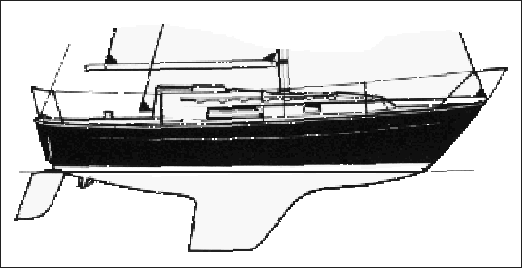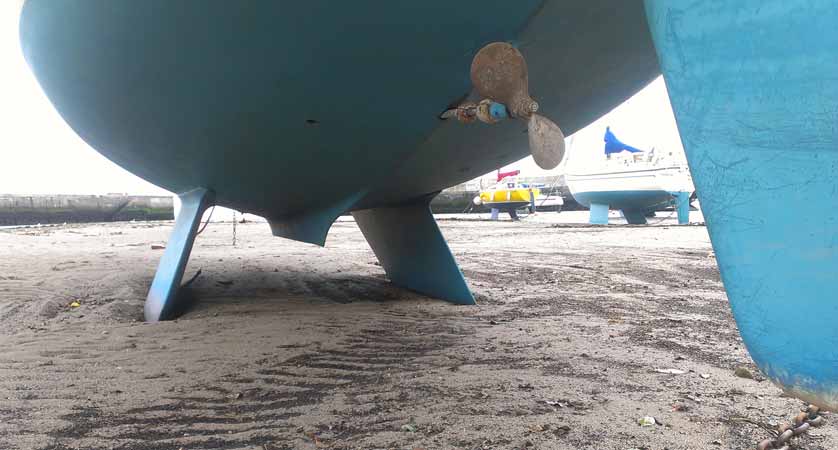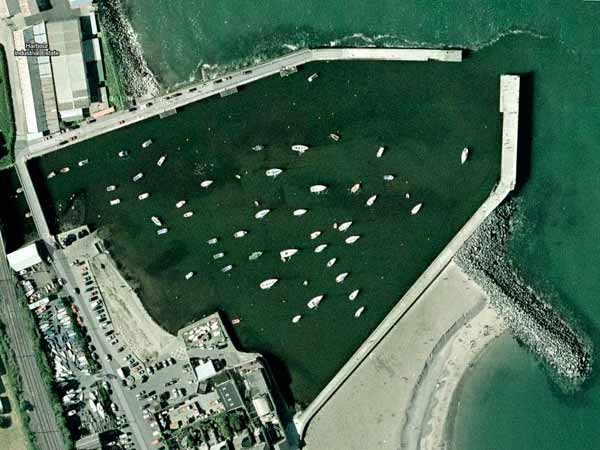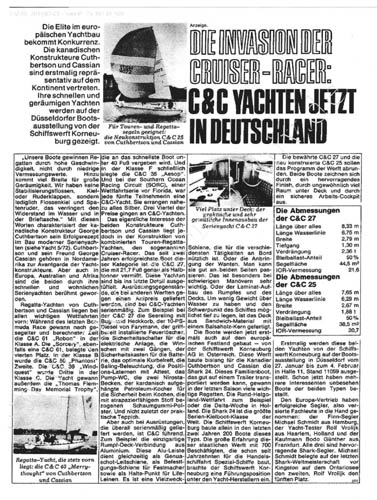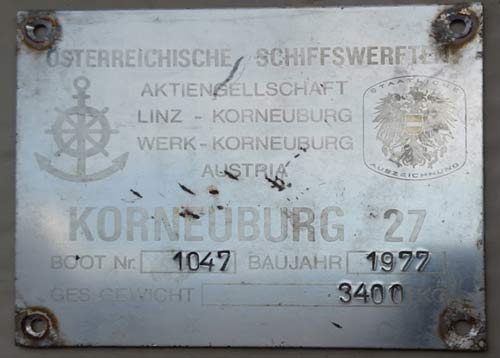
The C&C 27's Overseas Cousins – Trapper and Korneuburg
C&C built and sold impressive numbers of C&C 27's in North America; it was a popular boat. We forget, though, that its popularity extended to the right-hand side of the Atlantic, with not one but two builders turning out boats. One line was sold in the United Kingdom and Europe, primarily as the Trapper 500 and 501, for a total run between 620 and 650 boats. Another line was built and sold by Schiffswerft Korneuburg, just up the Danube from Vienna in Austria; these boats were much closer to the Canadian boats than the English ones, but we have no information on the numbers built (but we do have an intriguing mystery).
The Trapper Connection
Before the C&C 27 was drawn, a UK company called Anstey Yachts was already building the C&C design known here as the Viking 28. Anstey seems to have begun the process of acquiring rights to build the C&C 27 (correspondence with the owner of Algonquin indicates that some boats were imported as parts and assembled in Poole), but by the time the plug had arrived in Britain, Anstey had become part of another company, Deacons (see History of Trappers – the site design precludes specific page addresses).
The Trapper 500 was built at a rate of about 150 boats a year until the early eighties, when currency changes killed the export business to Europe, after which Deacons had them built by a third party. Deacons built or had built between 620 and 650 Trapper 500 and 501's. The 501, built until 1987, retained the original Mk I-style rig, but gained a re-styled cockpit and a more vertical, rectangular rudder akin to the Mk III's.
This page features Soubrette, a Trapper 500 owned by Ronan Laffan and moored south of Dublin in Bray, because she looks so different to North American eyes and because her conditions of use are dramatically different.
First, what's different about a Trapper? The first boats seem to have hewed quite closely to the Niagara-built 27, but soon acquired a quarter-berth where we have an icebox and a cast-iron keel in lieu of the lead keel. The new keel also put aside what Trapper owners call our 'shark-fin' keel in favour of a square foot better suited to drying out or 'taking the ground'. Harbours in which all the moorings and pier walls retain sailboat-friendly depths at all states of tide are much less common in England and Europe than they are in North America as tidal ranges are generally greater; sailors fully expect to tie up on a wall, go to dinner and return to find that there is nothing but mud under the keel. Having a keel that will keep the boat level fore-and-aft is therefore important (and knowing how to tie up so the boat doesn't topple sideways is really important).
The Trapper 500 was a C&C 27 Mk I in all but name. The interior evolved to suit British and European preferences and the rudder changed from the familiar scimitar to a more vertical rectangle similar to the Mk III rudder but without the rounded forefoot.
The final expression of adaptation to tides is the bilge keel; rather than one keel on the centreline, two keels are carried, mounted so as to provide a steady bipod on which the boat can stand when there is nothing but mud below her. The performance price is not high with well designed bilge keels; there is extra wetted surface, and they don't reach down far into undisturbed water, but when heeled, a boat with bilge keels has one keel vertical or near-vertical while the other's weight is canted well to the weather side where it does most good. As a capper, cleaning the bottom on a bilge-keel boat is no more difficult than scrubbing the deck, so there is no excuse for the carpet of growth that most fin-keel sailboats carry one or two months after launch.
This bilge-keel Trapper has twin keels standing out at an angle from the hull to support the boat when the tide is out, as seen here. Note that the hull was adapted for the bilge keels without removing the keel stub entirely. The stub has been shortened but not completely faired out. Soubrette's original rudder was C&C's distinctive scimitar-style rudder (as in the profile above). This rudder's post was bent when Soubrette took the ground hard as the tide fell in a strong north-easterly. The new, rectangular rudder gives a lighter, more balanced helm; it's also slightly less deep, so the earlier mishap is less likely to be repeated. Note the other bilge keel boats beyond, including a Trapper 501.
The tidal range in the Irish Sea is between 3 and 4 meters; as seen in the photo above, much of Bray harbour, the lighter green area, dries or becomes very shallow at low tide. The timing of the tidal cycle in Bray restricts the club to racing every other week.At springs, Bray's harbour dries except for the stream on the north side; at neaps, a small island dries in the centre and the rest becomes very thin. Having your mooring high and dry twice every 24 hours imposes some planning requirements on your coming and going, but for the adventurous, Bray is well placed. Ronan Laffan purchased Soubrette in the UK in 2003. "In our first year, we cruised to Scotland and Norway (2000NM in 8 weeks); the following year we cruised around Ireland, but since then kids have arrived and our sailing is less ambitious and our racing more irregular."
The defining issue in cruising these areas is tide, which imposes itself in a way that only sailors in north-eastern and north-western North America will appreciate. The tidal flows around headlands and through inter-island channels will stop or reverse a sailboat's progress, and when the wind is against the tidal flow, the resulting sea state is often likened to being in a washing machine. Soubrette's crew sailed from anchorage to anchorage rounding Scotland, often departing in the middle of the night to catch a favourable tide. It was 'very tiring,' Ronan admits.
The Korneuburg Mystery
C&C is welcomed with enthusiasm in 1973. The company did build boats in Kiel, Germany for many years after 1978, but the rising Deutschmark quickly made this a money-losing proposition (see the History of C&C Yachts page).While the history of Trappers is well known, with several sites devoted to them, the 27's of Schiffswerft Korneuburg are a puzzle. They show up from time to time on European brokerage sites and we have one in The Fleet (see Midnight Flyer; here's a brochure;and an announcement in the German yachting press (pdf for those who read German, picture below for everyone else). A Trapper owner also wrote of examining one on the Croatian coast). A simple question about production numbers to several key C&C Yachts people from that period, however, led to the discovery that no one from the C&C management or design teams of the day had ever heard of a Korneuburg 27. So it seems as though the Korneuburg people got away with a fast one. How did they get the moulds? Did they buy and import a 27, then 'splash' it? (Buying a competitor's boat, then making moulds from it is so common, particularly in motorboats, they have a word for it.) They even put the C&C logo on their brochure. Of course, that was easier to do then; today a casual Google search would expose the game, while in the 70's and 80's, all an unlicensed builder had to fear was a holidaying visitor from C&C. The question remains, was it a scam or did a C&C licensee decide he had the right to sub-licence the 27? We'll probably never know.
Korneuburg commissioning plate from Homer, now berthed in Holland. "Boot Nr." almost certainly refers to the total of all types of boats built, not a total of K27's and "Baujahr 1977" indicates they were building K27's well through the original's production lifespan (Canadian production of the Mk IV ended in 1982). The weight of 3400 kilos (nearly 7500 lb.) is probably closer the mark than C&C's figures.Schiffswerft Korneuburg, once a respected Danube shipyard with a history from 1849, has been gone since 1993, but many of the ships built there are still sailing (ships last a long time in fresh water, even if it's as polluted as the Danube) and there are several industrial-heritage web sites devoted to it (in German). Its main manufacturing hall appears to be a cultural centre and the rest of the site appears to have been developed as a mix of offices and waterside park – a nice contrast with the old C&C site, which is abandoned and derelict still. Naturally, no one has any idea how many 27's they built.
If anyone can shed any light on the Korneuburg issue, we'd love to hear about it.
